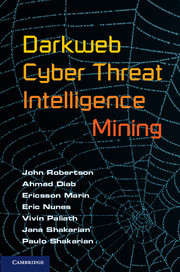Description
Darkweb Cyber Threat Intelligence Mining
Authors: Robertson John, Diab Ahmad, Marin Ericsson, Nunes Eric, Paliath Vivin, Shakarian Jana, Shakarian Paulo
This book describes techniques and results in cyber threat intelligence from the center of the malicious hacking underworld - the dark web.
Language: English
Subject for Darkweb Cyber Threat Intelligence Mining:
Approximative price 73.88 €
In Print (Delivery period: 14 days).
Add to cart
Publication date: 04-2017
146 p. · 15.6x23.5 cm · Hardback
146 p. · 15.6x23.5 cm · Hardback
Description
/li>Contents
/li>Biography
/li>
The important and rapidly emerging new field known as 'cyber threat intelligence' explores the paradigm that defenders of computer networks gain a better understanding of their adversaries by understanding what assets they have available for an attack. In this book, a team of experts examines a new type of cyber threat intelligence from the heart of the malicious hacking underworld - the dark web. These highly secure sites have allowed anonymous communities of malicious hackers to exchange ideas and techniques, and to buy/sell malware and exploits. Aimed at both cybersecurity practitioners and researchers, this book represents a first step toward a better understanding of malicious hacking communities on the dark web and what to do about them. The authors examine real-world darkweb data through a combination of human and automated techniques to gain insight into these communities, describing both methodology and results.
1. Introduction; 2. Moving to proactive cyber threat intelligence; 3. Understanding darkweb malicious hacker forums; 4. Automatic mining of cyber intelligence from the dark web; 5. Analyzing products and vendors in malicious hacking markets; 6. Using game theory for threat intelligence; 7. Application – protecting industrial control systems; 8. Conclusion – the future of darkweb cyber threat intelligence.
John Robertson is a student at Arizona State University pursuing undergraduate degrees in both Computer Science and Electrical Engineering, where his work was nominated for the Computing Research Association's Outstanding Undergraduate Researcher award. He is a recipient of an ARO Undergraduate Research Apprenticeship Program grant as well as two Fulton Undergraduate Research Initiative grants for his work involving the application of artificial intelligence techniques to cyber-security problems in the Cyber-Socio Intelligent System Laboratory with Dr Paulo Shakarian. Robertson also has industry experience as a software engineering intern with Microsoft on the Windows Core Development team.
Ahmad Diab is a Computer Engineering Ph.D. student at Arizona State University. His current work in the Cyber-Socio Intelligent System Laboratory focuses on the application of AI techniques to cyber-security problems. Diab is a recipient of the SIPGA award from ASTAR agency, Singapore. Previously, he was a Java developer at EtQ compliance Company. He holds a B.Sc. in computer engineering from Jordan University of Science and Technology.
Ericsson Marin is a Computer Science Ph.D. student at Arizona State University. He works at the Cyber-Socio Intelligent System Laboratory under the guidance of Dr Paulo Shakarian, with research projects in the intersection of Social Network Analysis, AI and Cyber-Security. He received his M.Sc. in Computer Science from the Federal University of Goias, Brazil and has published numerous papers in the area of social network analysis. He also has real-world experience as a software designer managing different software factories. In 2015, Marin was awarded with a Brazilian Science without Borders scholarship to pursue his Ph.D.
Eric Nunes is a Ph.D. student in the computer engineering program at Arizona State University. His research focuses on the intelligence techniques to cyber security problems. Previously, he was a Research Associate at
Ahmad Diab is a Computer Engineering Ph.D. student at Arizona State University. His current work in the Cyber-Socio Intelligent System Laboratory focuses on the application of AI techniques to cyber-security problems. Diab is a recipient of the SIPGA award from ASTAR agency, Singapore. Previously, he was a Java developer at EtQ compliance Company. He holds a B.Sc. in computer engineering from Jordan University of Science and Technology.
Ericsson Marin is a Computer Science Ph.D. student at Arizona State University. He works at the Cyber-Socio Intelligent System Laboratory under the guidance of Dr Paulo Shakarian, with research projects in the intersection of Social Network Analysis, AI and Cyber-Security. He received his M.Sc. in Computer Science from the Federal University of Goias, Brazil and has published numerous papers in the area of social network analysis. He also has real-world experience as a software designer managing different software factories. In 2015, Marin was awarded with a Brazilian Science without Borders scholarship to pursue his Ph.D.
Eric Nunes is a Ph.D. student in the computer engineering program at Arizona State University. His research focuses on the intelligence techniques to cyber security problems. Previously, he was a Research Associate at
© 2024 LAVOISIER S.A.S.




